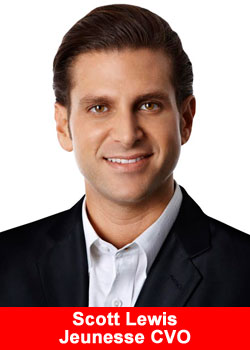![Jessica Herrin,CEO,Stella & Dot]()
Helaine Olen, contributing editor at Pacific Standard and author of Pound Foolish talks about how home party companies are making waves, specifically in Silicon Valley:
The invitations began arriving shortly after I moved back to my native New York City in 2012. They all sounded eerily similar. Each offered a chance to spend some fun, quality time in an intimate setting with a few fellow moms—or “the girls”—while some sort of product, usually but not always clothing, was “shared.”
One of them beckoned me to a “trunk show” of jewelry and accessories by the company Stella & Dot, to be held at an Upper West Side brownstone. Another offered “a chance to share girlfriend time, refreshments and shop [sic]” for garments bearing the Ruby Ribbon label, a clothing and undergarment line.
A little Googling confirmed my suspicion: Like Amway and Mary Kay, these newer companies are multi-level marketing programs. Which is to say they offer their salespeople two ways to make money: by selling products directly to friends and neighbors, and—far more efficiently—by selling friends and neighbors on the idea of becoming salespeople themselves, and collecting a commission on their recruits’ earnings.
Suffice it to say, this was not exactly what I expected from a move to modern Manhattan.
At first, the invitations made me feel nostalgic. In-home sales events were not uncommon when I grew up in blue-collar Brooklyn back in the 1970s and ’80s. But it was also a queasy-making sort of memory—and not just because of the social awkwardness that tends to go along with being pitched by a neighbor.
“It’s an opportunity to sell an opportunity,” says Robert FitzPatrick. “Your business is recruiting people to host parties.”
Multi-level marketing operations exploded across America in the ’70s, mobilizing legions of strivers to hawk vitamin supplements, nutrition shakes, and beauty products to their loved ones and acquaintances. The companies made big promises, but were often built less to bring viable products to market than to allow a few people at the very top of a sales network to capitalize on the American belief in easy prosperity itself—and, in many cases, on women’s desires for some degree of financial and social independence from their husbands.
The industry quickly acquired a tawdry reputation, facing years of overwhelmingly negative coverage in the press. “The media sometimes have trouble distinguishing between MLM companies and illegal pyramid schemes,” wrote a droll David Owen in the Atlantic back in 1987. “In fairness to the media, it should be said that MLM companies have often made it difficult for the media to emphasize anything but the negative.” Owen cited the industry’s extremely high failure rate, as well as the tendency of multi-level marketing firms to fall under state investigations. “In addition,” Owen wrote, “MLM companies tend to do most of their business with some of the more vulnerable segments of the consuming population: senior citizens, people from rural areas, people without much education, and people from California.”
Yet here I was, hearing about a flurry of sales events in places like elite New York preschools and million-dollar homes in Connecticut’s hedge fund belt. My curiosity was piqued.
As it turns out, the direct sales industry is not only going upscale in some quarters, it’s going gangbusters in general. According to the Direct Selling Association, there were an estimated $32.67 billion in direct sales in 2013, an almost 10 percent increase since 2008. Old-line multi-level giants like Amway and Herbalife have a lower profile in the American popular consciousness than they used to, but they have been aggressively expanding into other countries; both are especially huge in China.
When these firms do show up in the U.S. media, it’s usually in the familiar light. Over the past couple of years, for instance, the investor Bill Ackman has been crusading against Herbalife, accusing the nutritional supplement behemoth of being a “global pyramid scheme.” Latino advocacy groups have accused the firm of targeting striving Hispanic immigrants, to boot. Ackman’s hedge fund has bet a billion dollars against the company. (Herbalife disputes all these accusations.)
And yet, a kind of multi-level marketing parallel universe has cropped up recently here in America. In this other world, the media’s vigilant skepticism toward the industry has eased up rather markedly. “Move over Tupperware—home sales parties have gotten hipper and higher end,” a recent headline from the Washington Post’s Express blared. “Recruits aren’t your grandmother’s Avon Ladies,” proclaimed Crain’s New York Business in 2013. In 2012, the New York Times breezily described a Stella & Dot trunk show as “a direct-sales soiree,” while thePittsburgh Post-Gazette advised that “jewelry not only can be a source of style but also self-empowerment.”
This turnaround in attitude may simply reflect the American tendency to worry over the moneymaking activities of lower-class women and men, and coo over those of the upper crust. But there’s also something else going on, and it has to do with where these newer companies are coming from, and the new cultural soil in which they are being planted.
This new crop of multi-level marketing programs has, to a large extent, emanated straight from Silicon Valley. And in contrast to the New Age or middle-American business-speak that hyped the opportunities held out by old-line direct-marketing firms, these new entrants have been draped in all the tech world’s culturally ascendant values and buzzwords. As Courtney Winget, the chief marketing officer for Rodan + Fields, a multi-level skincare line, told the San Francisco Business Timesin 2013, “direct selling was the original social network.”
Anna Zornosa, the founder and CEO of Ruby Ribbon, was a vice president at Yahoo before she got into what she calls “social commerce.” And Jessica Herrin, the brains behind Stella & Dot, worked at a few tech start-ups and at Dell before her move into what she calls “social selling” and “flexible entrepreneurship.” Ruby Ribbon is backed by the Menlo Park-based Trinity Ventures. Stella & Dot has been championed by the star venture capitalist Alfred Lin, who also took stakes in Airbnb and Uber. In 2011, the venture firm where Lin is a partner, Sequoia Capital, invested $37 million in the company.
In a culture that increasingly valorizes start-ups and social entrepreneurship, and an economy that keeps ordinary people always on the lookout for the next gig or “side hustle,” it makes sense that these firms have found a warm reception. But how different are these new multi-level marketing programs from their predecessors—and how are they the same?
DURING THE HOUR I spend with the Stella & Dot saleswoman Naomi Perkins Rosenstein, she pitches me at least twice. Rosenstein and a recent recruit named Sabrina Clark have set up open meetings at four coffee shops around Manhattan to discuss Stella & Dot accessories—the virtues of purchasing them, yes, but also of selling them—with any interested parties. At Think Coffee in the uber-hip East Village, the two women—“stylists,” in the company’s lingo—have covered a table with jewelry. They are wearing more jewelry still: earrings, bracelets, silver-colored necklaces; a barrage of statement pieces. But it’s a rare gorgeous sunny day during a less than pleasant spring, and business is slow. Unless you count me, the reporter.
The first pitch comes as I’m rummaging through my elderly tote, hunting for my tape recorder. Rosenstein suggests the Stella & Dot Madison Tech Bag, the red handbag that Clark is carrying. It’s $158. I decline.
Then, as we are wrapping up the interview, Rosenstein asks if I would care to host a Stella & Dot trunk show, to “get the full feel” of the direct-sales experience for my article. “We’re really big on themes. So: champagne and cupcakes, muffins and mimosas,” she says. “And all we do is get your friends together to come over to your house for, literally, a private shopping experience.” I pass.
Jessica Herrin, the founder of Stella & Dot, got her first taste of start-up success while a student at Stanford Graduate School of Business way back in 1996, when she launched one of the first online wedding gift registries. The story of her business landed her on Oprah; she says she was inundated afterward with messages from women in the audience who wanted to become entrepreneurs like her. So she began looking for ways to “democratize entrepreneurship.”
She began experimenting with the party sales formula in 2003 with a start-up called Luxe Jewels. But she didn’t strike gold till she joined forces with the jewelry designer Blythe Harris in 2007. The two renamed the company Stella & Dot in honor of their grandmothers.
As the American economy imploded, revenue at the newly renamed company exploded. Stella & Dot, which is privately held, says it went from $33 million in annual sales in 2009 to $220 million in 2013. It contracts with more than 18,000 in-home stylists in six countries, including the United States, Canada, the United Kingdom, and Germany.
A kind of multi-level marketing parallel universe has cropped up recently here in America. In this other world, the media’s vigilant skepticism toward the industry has eased up rather markedly.
Over the course of 2013, Stella & Dot held 171,000 sales events and parties, designed to appeal to women between the ages of 25 and 45. Stylists are encouraged to host or co-host the kinds of parties where their “girlfriends” can let loose and have fun while ordering from a sample collection. For every event they host, Stella & Dot stylists receive a commission of 25 to 35 percent of sales. Orders arrive at a customer’s home a few days later, in packaging bedecked with cheerful, you-go-girl aphorisms like “you’ve got smarts and style.”
To its credit, unlike some of the most controversial multi-level marketing firms, Stella & Dot does not require its salespeople to purchase inventory. New stylists must pay $199 for a starter kit, which contains $350 worth of jewelry for display, and they typically spend another $500 or so on other start-up costs, according to Herrin—a modest set of upfront expenses. And unlike the honeybee propolis pills and anti-aging creams of yesteryear’s MLM, there’s a genuine market for the company’s products. Stella & Dot’s boho-chic bracelets and chain-link necklaces have been snapped by paparazzi on celebrities like Katy Perry, Olivia Munn, and Amy Poehler. Instagram, Pinterest, and Facebook pages featuring its jewelry and other accessories litter the Internet.
But even with an appealing product, it’s easy for a local market to become saturated when distribution occurs within an overlapping social network. As is almost always the case with multi-level marketing, the real money comes from recruiting more saleswomen.
Naomi Perkins Rosenstein began selling Stella & Dot in 2010, after ordering a necklace she saw on the TV show Bachelor Pad. A gregarious middle-school reading specialist, she decided to host a party and invited 100 acquaintances to her home. Twenty-six turned up; six went on to host their own trunk shows. By 2012, Rosenstein was doing well enough to leave her job. Today she has more than 100 stylists working beneath her, including 20 who have been recruited by other “team members.”
To use the old-fashioned lingo of MLM, all of these saleswomen constitute Rosenstein’s “downline”: Money flows to her from all of them in the form of a small commission on each sale. This is the real core of the model. “It’s an opportunity to sell an opportunity,” says Robert FitzPatrick, the operator of the website Pyramid Scheme Alert, regarding party-plan MLM companies. “Your business is recruiting people to host parties.”
In Stella & Dot’s booklet for new recruits, newbie stylists are instructed to “create a running list of potential Stylists and/or Hostesses.” The list, it says, could include friends, neighbors, relatives, your kids’ friends’ parents, co-workers (yours and your spouse’s), people from church, hairstylists, teachers, and anyone you invited to your wedding, among other categories. Recruits are told to “warmly offer the opportunity to host to each person on your list.”
While this might sound uncomfortable to some, Herrin is unapologetic about this intrusion of commerce into personal relations. “You met this nice lady in the living room, and you trust her and she’s a friend of a friend,” Herrin explains. “You are connected to them socially. They know you. They know where you are going. And it’s done in a way that’s not a way that creeps you out.”
Yet this kind of pitch is a large part of what was once considered socially uncouth about multi-level marketing. “The standard justification MLM people use is that you are offering your friend/acquaintance a wonderful opportunity,” wrote Brian Bloch, then a business professor at the University of Auckland, in the Journal of Consumer Marketing in 1996. “But 90-95 percent of them will not see it this way and for one very good reason. You would be making money out of them, and making money out of friends is not, in our society or most others, acceptable behavior.”
It’s not clear, however, that this kind of behavior is quite as unacceptable as it once was.
A CENTRAL PREMISE OF the so-called sharing economy—a misnomer—is that we can all harness a bit of profit by monetizing parts of our private lives that are now lying fallow. You can rent out your spare bedroom on Airbnb, or charge rents for your car and your services as a driver with Lyft. At the same time, a central premise of the “social” economy is that social networks are some of the best things to monetize. As various merchants prompt us to “share” our online purchases on Facebook, thus hoping to make a buck on the back of our social network, it’s not such a leap for people to start thinking about how they can monetize friendship themselves.
These shifting norms may provide cover for the otherwise awkward social dynamics of multi-level marketing, and help put the firms in a new context that raises their reputation. But the true appeal of these businesses, I think, stems from desperation.
Herrin talks about how Stella & Dot has helped women pay for IVF treatments, or remodel a home, or supplement a stable income with a few hundred extra dollars a month. But women also resort to Stella & Dot out of real economic need. The company, Herrin tells me, allows struggling women to “create [their] own economic stimulus package.”
In 2009, under the headline “Direct Sales as a Recession Fallback,” theNew York Times profiled a Stella & Dot saleswoman living in the upscale Silicon Valley suburb of Burlingame, California, who “sells jewelry because she needs cash, and she needs it quickly.” Direct sales is a business “that bizarrely works best when times are bad,” the TV investing guru Jim Cramer has said. “In a recession, a lot of people lose their jobs and decide to become sales reps.”
The Great Recession may be over, but household incomes are still stagnant or falling, even as the costs of housing, health care, and education continue to skyrocket. Even many high-income people find themselves under enormous financial pressure. “The cost of living has gotten so high that no one feels safe or secure. People may appear upper middle class, but look at them. They have kids. How are they going to put them through college?” says FitzPatrick. “So, suddenly this thing has wider and wider appeal. What used to be something that was subject to ridicule has gained greater and greater respectability.”
But is multi-level marketing really the answer? Companies like Stella & Dot tend to spotlight highly successful saleswomen like Rosenstein, but they also say that many of their salespeople are merely seeking what my grandmother would call “pin money.” While we don’t actually know what most stylists hope to get out of Stella & Dot, we do have a sense of how they’ve been doing. In 2011, according to a profile of Herrin in Moremagazine, the average Stella & Dot stylist earned less than $300 a month—a figure that doesn’t account for overhead expenses. All the aphorisms about empowerment and the you-go-girl slogans, says Stacie Bosley, an assistant professor of economics at Hamline University who studies multi-level marketing, are designed to make people think more about the mission than the money.
Lord knows, anyone can use a little empowerment in this economy. But alas, a heavy reliance on uplifting rhetoric is one aspect of direct sales that hasn’t changed much since the 1970s. Multi-level marketing has always been big on pep talks.
There’s now even a multi-level marketing company for children, called Willa, whose tween and teen saleswomen market skincare products to their peers and “earn money by recruiting other sellers,” according to the Wall Street Journal. Founder Christy Prunier says on the firm’s website that she wants to “empower girls”—as if having 12-year-old girls sell other 12-year-old girls a pack of cucumber masks for $42 is a mission on par with Betty Friedan’s, and not just a way to make a buck.





.jpg)
.jpg)











































































































d%20Global%20Network/Fabio-Galdi.jpg)
![Roberto Forlani, Power Clouds CEO (on the left) | Alfonso Galdi WOR(l)D Global Network CFO (on the right)] Roberto Forlani, Power Clouds CEO (on the left) | Alfonso Galdi WOR(l)D Global Network CFO (on the right)]](http://www.businessforhome.org/wp-content/uploads/image/Wor(l)d%20Global%20Network/Power-Clouds.jpg)



